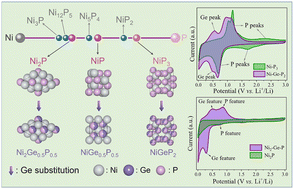Novel Ni–Ge–P anodes for lithium-ion batteries with enhanced reversibility and reduced redox potential†
Abstract
Nickel phosphides as anode materials for lithium-ion batteries (LIBs) have attracted much attention due to their large theoretical capacities and great phase diversity. However, the obstacles of large volume expansions, sluggish Li diffusion kinetics, and poor reversibility hinder their practical applications. Herein, we introduce Ge into the Ni–P system using a mechanical alloying method to synthesize Ni–Ge–P composites as novel anodes for LIBs. The results show that the Ge-substituted Ni2Ge0.5P0.5, NiGe0.5P0.5, and NiGeP2 compounds of the Ni–Ge–P composites possess higher crystal symmetry and larger cell volumes than the structurally similar Ni2P, NiP, and NiP3, respectively. When used as anodes, the Ni–Ge–P anodes exhibit enhanced electrochemical reversibility and reduced redox potential compared to the Ni–P anodes. Furthermore, the Li-storage mechanism of a selected NiGe0.5P0.5/Ni2Ge0.5P0.5 composite was investigated, and the result shows that it undergoes a conversion-type reaction, along with the generation of the Ni, Li2Ni12P7, LiP, Li3P, and LixGe phases. In addition, a topological conversion reaction mechanism between the Ni2P-type structure and Li2Ni12P7 was proposed. Moreover, a Ni–Ge–P2/C composite was synthesized to improve the cycling performance of Ni–Ge–P2. This method of regulating the electrochemical properties of materials by Ge substitution for P offers new insight into designing high-performance anodes.



 Please wait while we load your content...
Please wait while we load your content...